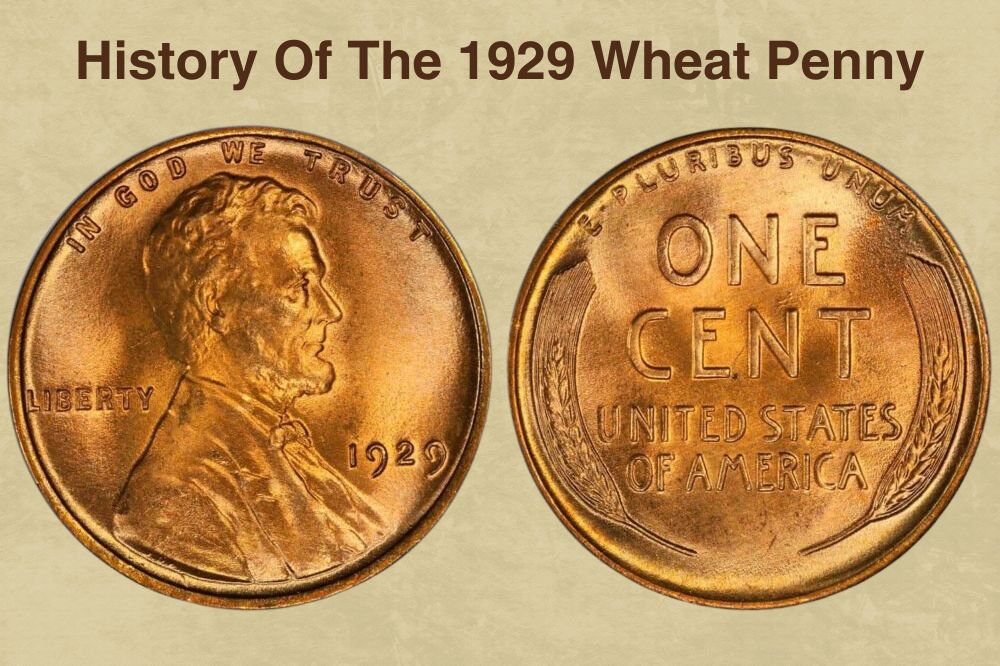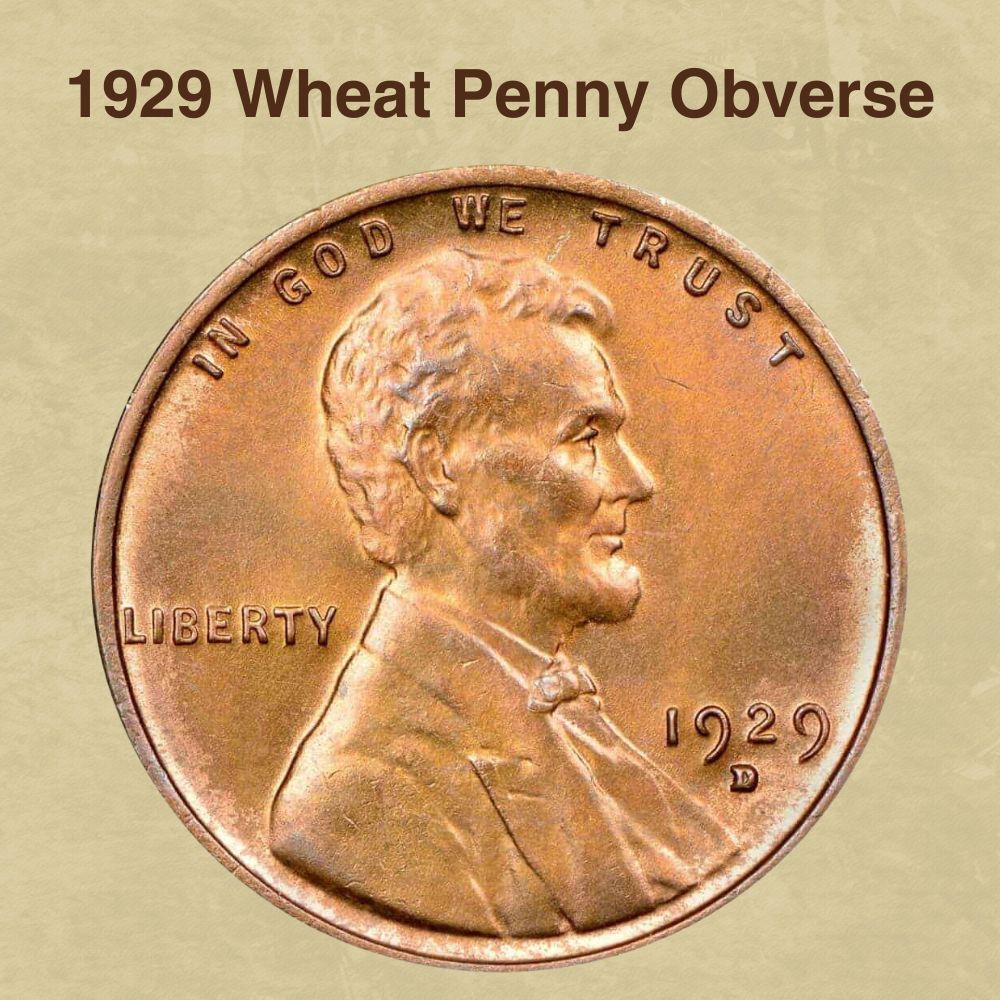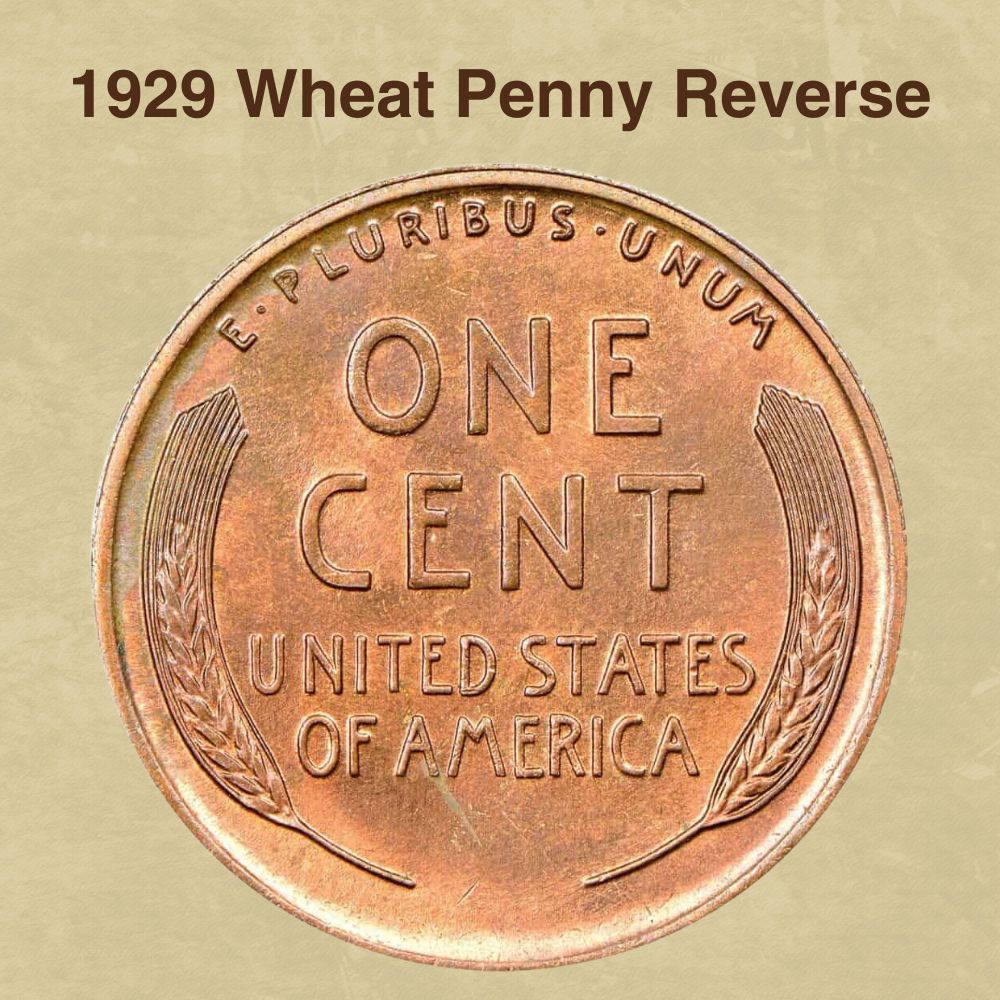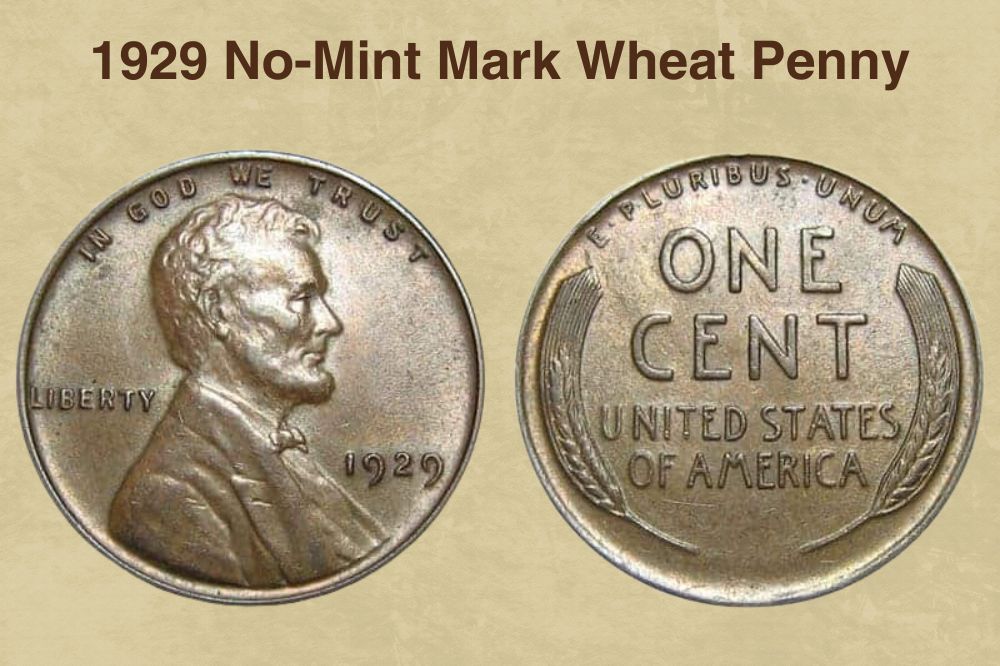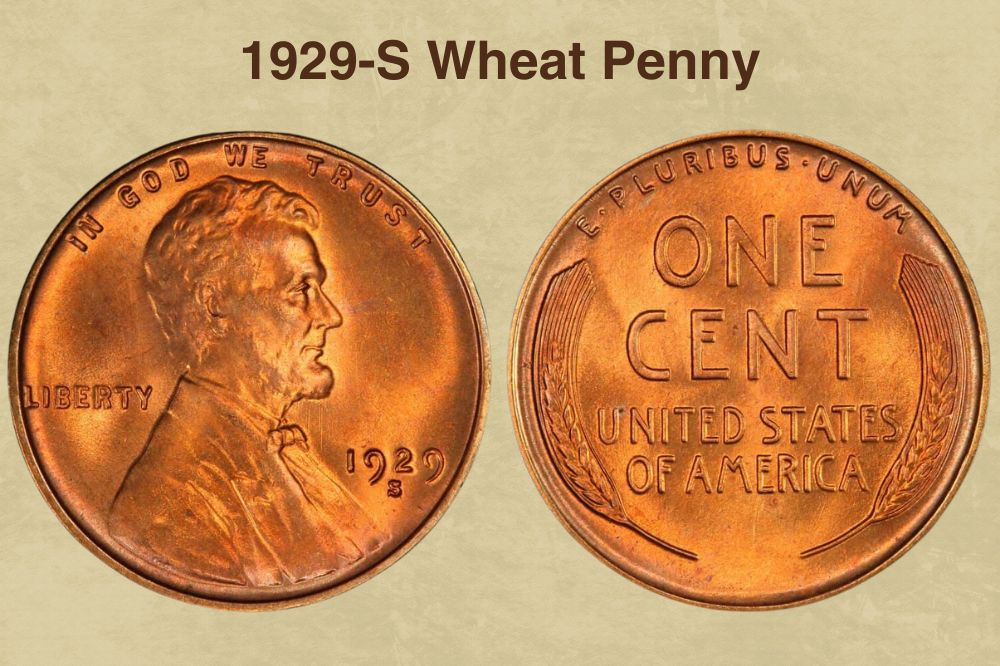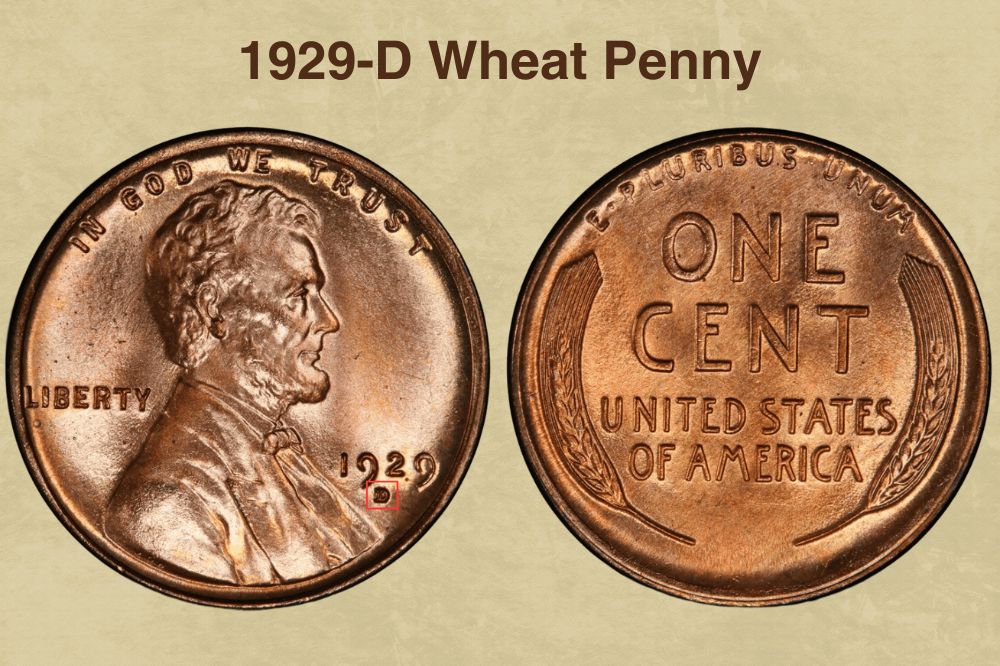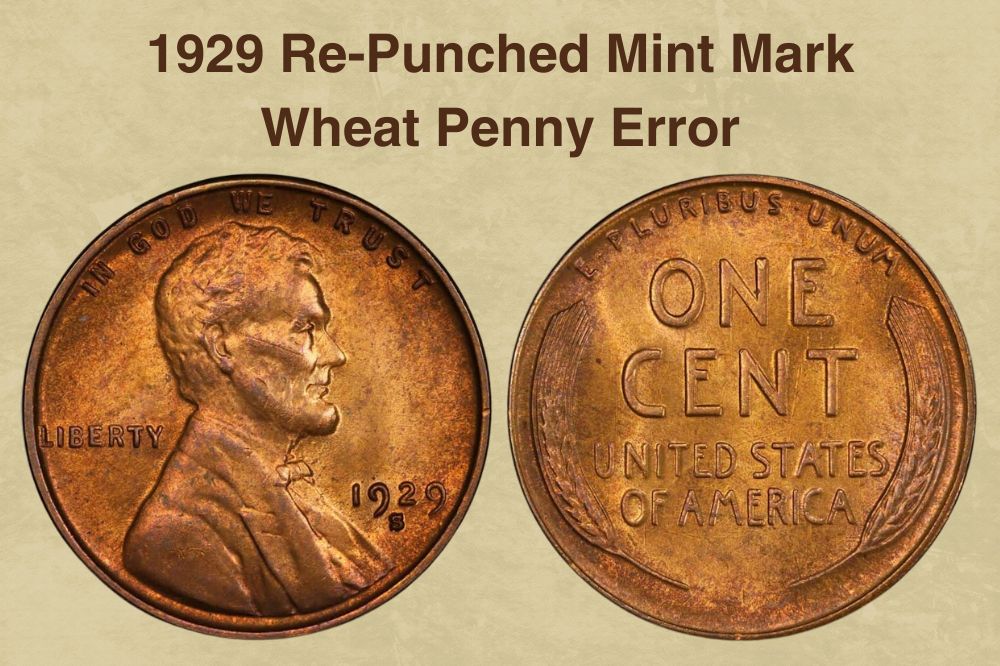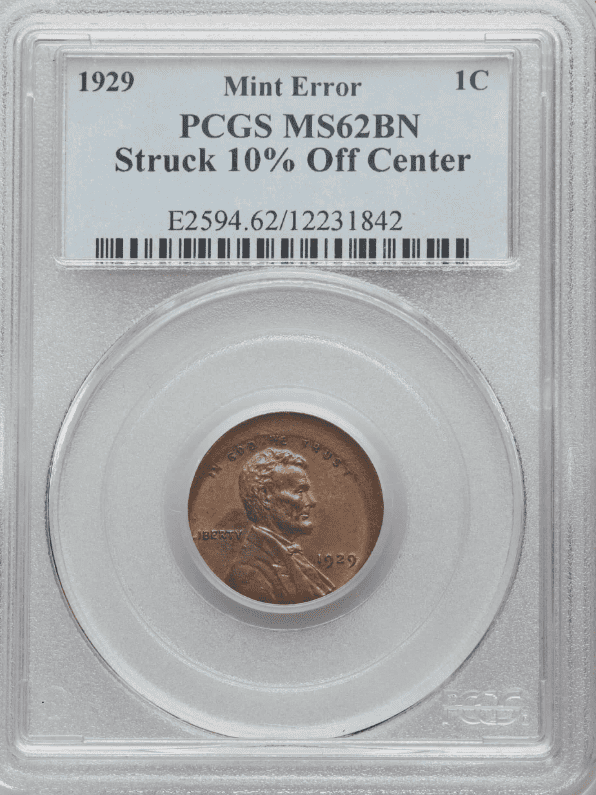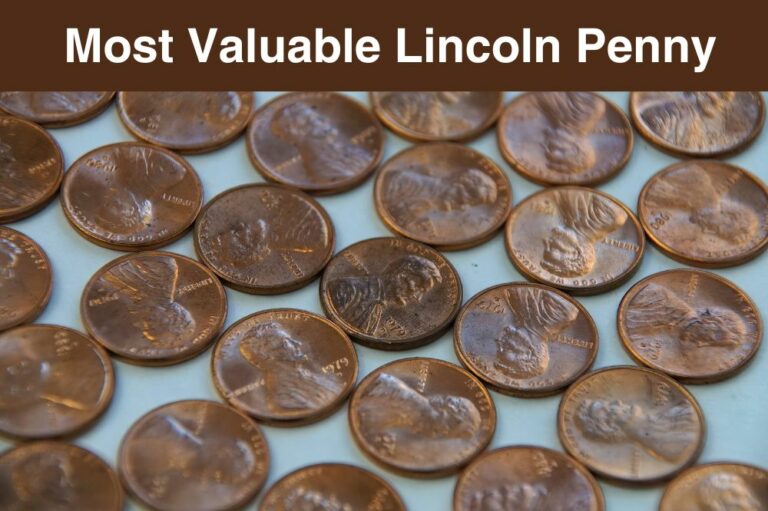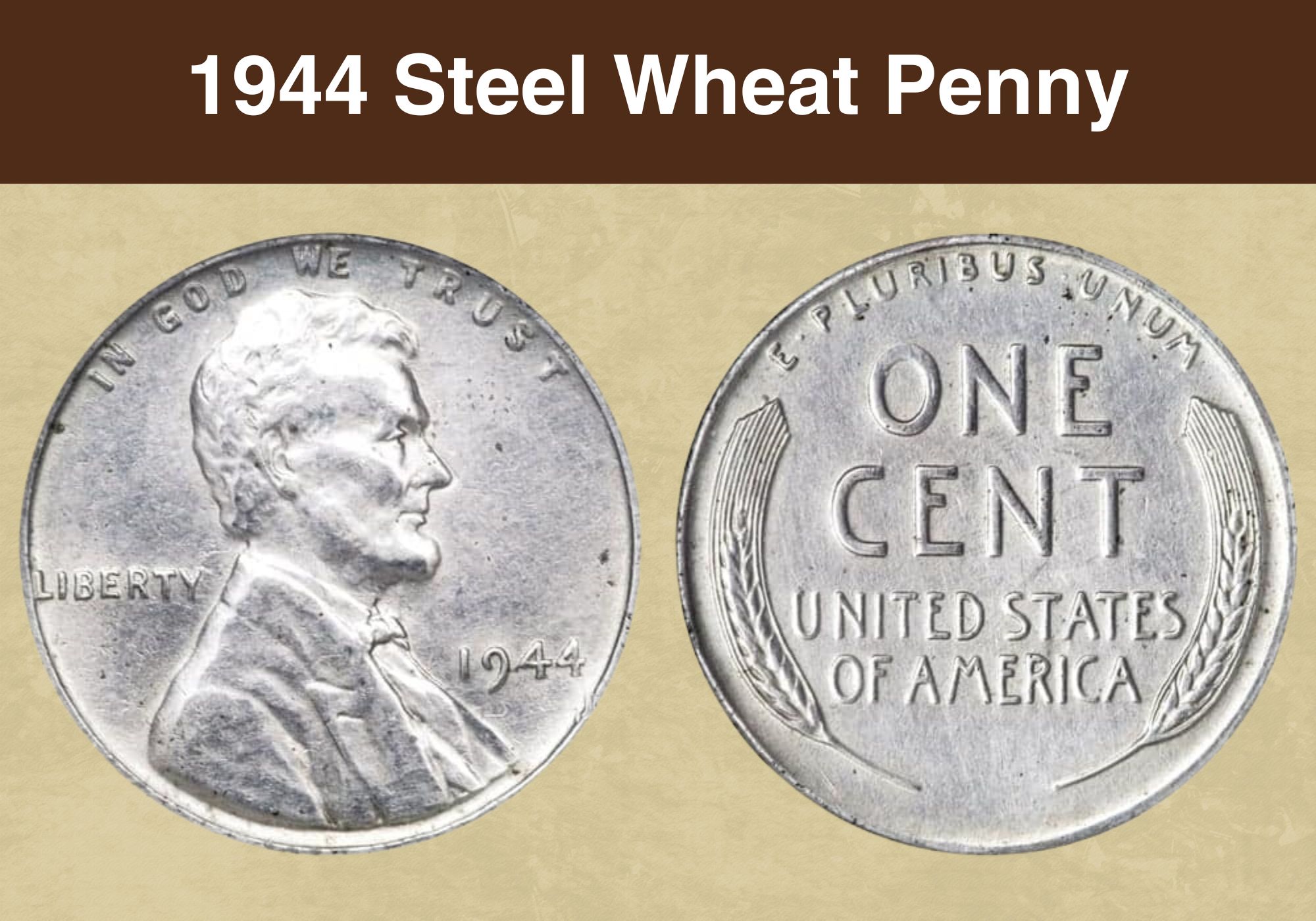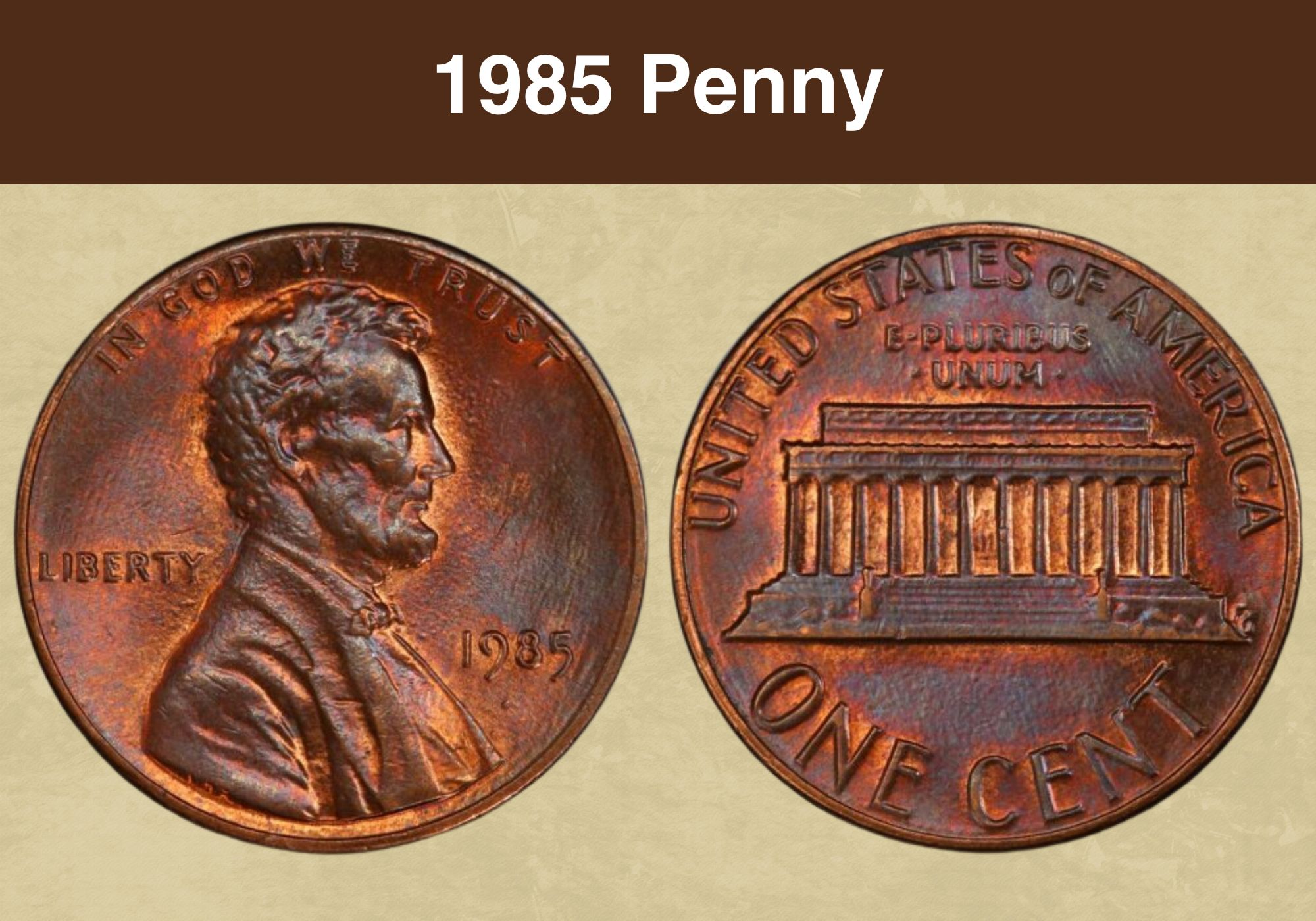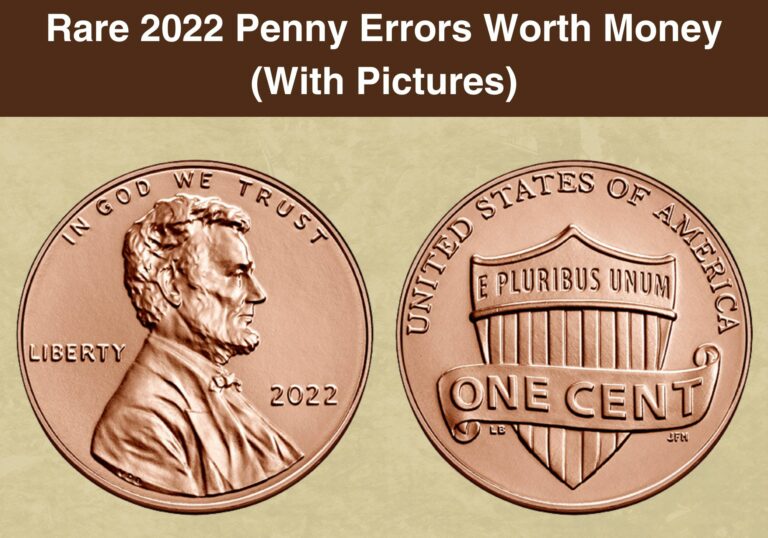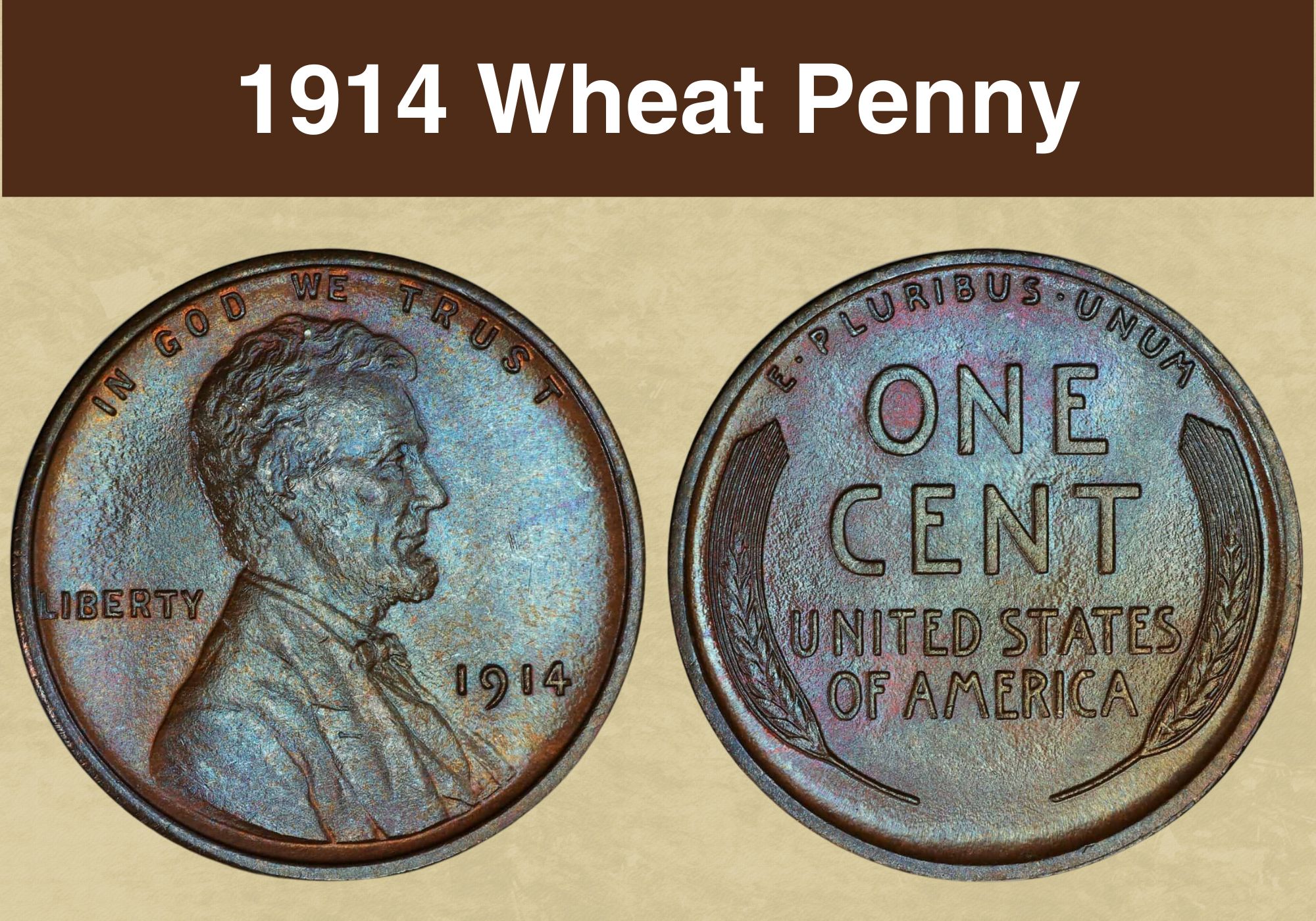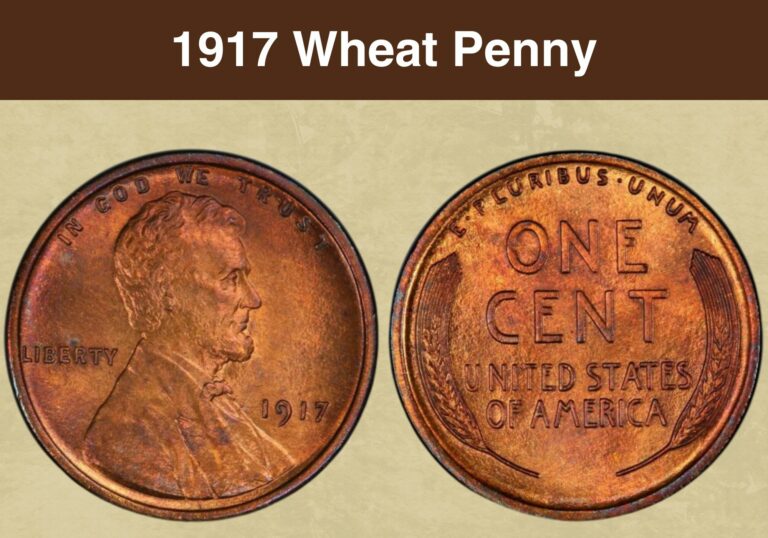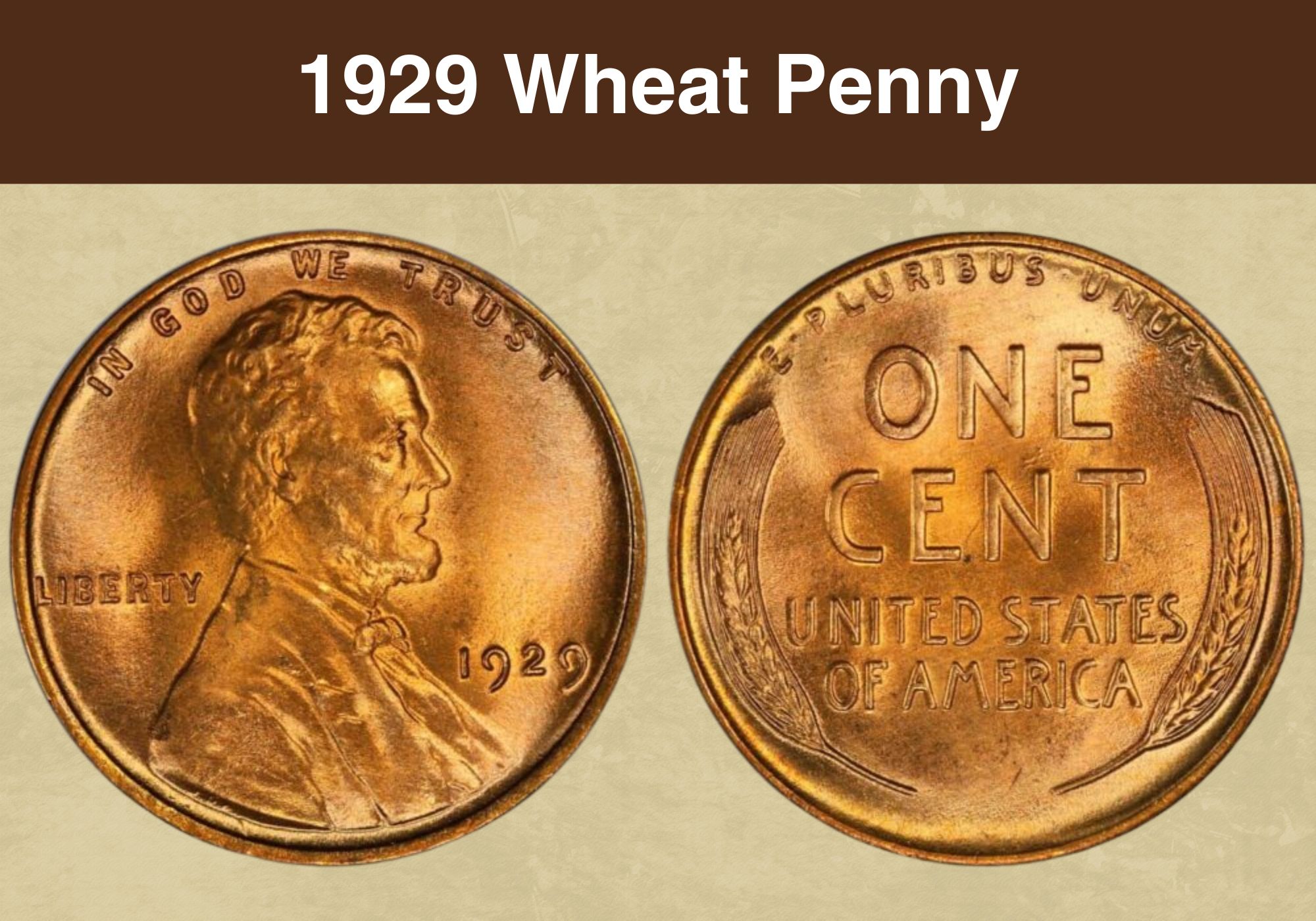
Coin Value Contents Table
- 1929 Wheat Penny Value Chart
- The History of the 1929 Wheat Penny
- Features of the 1929 Wheat Penny
- 1929 Wheat Penny Grading
- 1929 Wheat Penny Value Guides
- 1929 No-Mint Mark Wheat Penny Value
- 1929-S Wheat Penny Value
- 1929-D Wheat Penny Value
- Rare 1929 Wheat Penny Errors List
- Where to Sell Your 1929 wheat penny ?
- FAQ
Do you own a 1929 wheat penny and wonder how much it might be worth?
Or are you considering adding a 1929 wheat penny to your Lincoln coin collection?
You’ve come to the right place! In this guide, you will learn everything you need to know about the 1929 wheat penny value.
We will explore a bit of the coin’s history, its unique features, and how much it is worth in the circulated and uncirculated condition.
Being an old coin, the 1929 wheat penny is rarely found in mint state. If you are lucky enough to own an uncirculated example, it might be worth hundreds of dollars!
Let’s jump in and find out just how much your 1929 Lincoln cent is worth.
1929 Wheat Penny Value Chart |
||||
| Mint Mark | Good | Fine | Extremely Fine | Uncirculated |
| 1929 No-Mint Mark Wheat Penny | $0.25 | $0.35 | $3 | $90 |
| 1929-S Wheat Penny | $0.50 | $1.50 | $6.50 | $160 |
| 1929-D Wheat Penny | $0.50 | $1.25 | $6 | $250 |
The History of the 1929 Wheat Penny
The United States Mint struck the Lincoln cent in 1909 as part of Abraham Lincoln’s bicentennial anniversary. At the same time, President Theodore Roosevelt had suggested that the Mint redesign the four gold coins and the cent.
So, in 1905, the Mint appointed sculptor Augustus Saint-Gaudens to prepare new designs for the cent and the four gold coins. Gaudens completed designs for the gold coins but passed away before submitting designs for the cent.
Subsequently, the Mint selected another sculptor, Victor David Brenner, to complete redesigning the cent, proposing that Abraham Lincoln’s portrait appear on the obverse of the newly-design coin.
Before this, Roosevelt had sat for Brenner for the creation of a portrait for the Panama Canal Commission. What the two discussed is unknown, but it is known that the president admired Brenner’s portrait of Lincoln on a plaque he had created.
It could be that Roosevelt recommended Brenner to the Mint, which eventually selected him to design the Lincoln cent.
The obverse of the new coin featured President Abraham Lincoln’s portrait while the reverse showed two wheat ears, thus the name ‘’wheat penny.’’
David Victor Brenner also prominently placed his initials (DVB) on the reverse, but these initials were removed following a public outcry. But at this time, a few coins had already been minted, creating a frenzy among collectors who named these coins DVB.
Initially, the wheat pennies comprised 95% copper, but this composition changed for one year in 1943 to a zinc-coated steel. The 95% copper composition resumed in 1944 until 1982, when copper became too costly, and Lincoln cents were struck in zinc core with a copper coating.
The U.S. Mint still produces Lincoln pennies to date, but the coin’s design has changed over the years.
Also read: 12 Most Valuable Lincoln Penny Worth Money
Features of the 1929 Wheat Penny
Let’s now look at the features of the 1929 wheat penny. By familiarizing yourself with these features, you will know what to look for when grading your wheat penny.
The Obverse of the 1929 Wheat Penny
The obverse or head side of the 1929 wheat penny features the right-facing portrait of President Abraham Lincoln. This portrait takes up the majority of the coin’s surface.
The words IN GOD WE TRUST appear at the top above Lincoln’s head and along the coin’s inner rim. Meanwhile, the word LIBERTY is shown on the left behind the president’s back, while the date appears to the right of the portrait.
The Reverse of the 1929 Wheat Penny
The reverse of the 1929 wheat penny features a simple design showcasing two wheat leaves, one on the left and the other on the right.
The coin’s denomination, ONE CENT, appears prominently in the middle of the coin, followed by the country’s name, UNITED STATES OF AMERICA.
The motto, E PLURIBUS ENUM, is shown at the top around the coin’s inner rim.
Other Features of the 1929 Wheat Penny
The 1929 wheat penny measures 19.00 millimeters and weighs 3.11 grams. It is made of 95% copper, 5% tin and zinc.
The coin has a plain edge, and you will notice a mint mark S or D on the obverse underneath the date.
The 1929 wheat pennies with the mint mark S or D were struck in San Francisco and Denver, respectively; those minted in Philadelphia do not have an identifying mint mark.
Also read: 13 Most Valuable Wheat Penny Worth Money
1929 Wheat Penny Grading
Most early wheat pennies were well-struck, but weak dies resulted in poor strikes from about 1915 to the mid-1930s.
Since most 1929 wheat pennies are circulated and worn, it is best to focus on uncirculated and gem-like examples to get the most value for money, whether you are selling or buying.
While circulated examples will usually be brown in color, gem-like wheat pennies will have a red, shiny luster. Coin in mint state have retained their original luster and show very few, if any, contact marks.
The obverse will be flawless, with no visible dings or marks on the fields or Lincoln’s face. On the reverse, there are no visible contact marks, scratches, or blemishes on the fields or the denomination, ONE CENT.
| # | Grade |
|---|---|
| 1 | Basal State-1 |
| 2 | Fair |
| 3 | Very Fair |
| 4, 5, 6 | Good |
| 7, 8, 10 | Very Good |
| 12, 15 | Fine |
| 20, 30 | Very Fine |
| 40 | Extremely Fine |
| 50 | About Uncirculated |
| 60 | Mint State |
| 65 | Mint State |
| 70 | Mint State |
Please check our grading guides to know your coin scale, It’s the necessary step to know the exact value of your coin.
Check out now: How to Grade Lincoln Wheat Penny?
1929 Wheat Penny Value Guides
In this section, we’ll answer the question: How much is a 1929 wheat penny worth?
Several factors will affect the value of your wheat penny, including its condition, color, and rarity. There are three varieties of the 1929 wheat penny. These are the:
- 1929 No-Mint Mark Wheat Penny
- 1929-S Wheat Penny
- 1929-D Wheat Penny
Let’s look at the value of each coin.
1929 No-Mint Mark Wheat Penny Value
The mint in Philadelphia struck an estimated 185,262,000 wheat pennies in 1929. You guessed right if you thought that’s a lot of pennies!
Due to the high mintage, the 1929 no-mint mark wheat pennies are very common. Even gem-quality red pennies from this year are relatively accessible at pocket-friendly prices.
A 1929 no-mint mark wheat penny in circulated condition will fetch between $0.20 and $6 for a brown coin. One in uncirculated condition will bring up to $90.
Red coins are the most desirable and will typically be in gem condition. You can expect about $29 for a 1929 red wheat penny graded MS62, but this price can go as high as $7,000 for gem-quality examples.
In 2014, Heritage Auctions sold what is, to date, the most expensive 1929-P wheat penny for a whopping $5,581. The coin was red-colored and graded MS67.
1929-S Wheat Penny Value
About 50, 148,000 wheat pennies were struck at the San Francisco mint in 1929.
This is a significantly lower mintage than the number of cents struck in Philadelphia. But 1929-S pennies are still very common in all grades because many of these coins were saved in rolls, making them readily available for picking.
Like most coins struck in the 1920s, the wheat pennies coming from San Francisco in 1929 show signs of moderate to heavy die erosion; gem examples that are well struck are relatively hard to come by.
The 1929-S wheat penny is worth between $0.50 and $18 in circulated condition. Uncirculated examples graded MS66 can fetch as much as $160, while fully red coins can bring in up to $8,300.
During a 2022 sale, Heritage Auctions sold a red 1929-S wheat penny graded MS66+ for an eye-watering $18,600.
1929-D Wheat Penny Value
Wheat penny values struck in Denver will feature a mint mark D right below the date. Approximately 41,730,000 wheat pennies were struck at the mint in Denver, the lowest mintage in 1929.
Many of the 1929 wheat pennies from Denver demonstrated poor strike due to the Mint using worn-out dies. You will notice a lot of blurring on the wheat years on the reverse and on the date and Lincoln’s portrait.
Fully struck Lincoln cents from this year are rare, but these coins are generally common in all grades.
Expect between $0.35 and $20 for a 1929 wheat penny in circulated condition, but this price can increase to $250 for 1929-D Lincoln cents graded MS66.
Red-colored, fully gem 1929-D wheat pennies are rare. But if you are lucky enough to own one, you can expect about $2,650.
The most expensive 1929-D wheat penny was graded MS66+ and sold for $7,800 during a 2021 Heritage Auctions sale.
Also read: 17 Most Valuable Indian Head Penny Worth Money
Rare 1929 Wheat Penny Errors List
Errors can sometimes increase a coin’s value. But not all errors are desirable; knowing which errors to look for can help you identify 1929 wheat pennies worth hundreds or even thousands of dollars.
Here are the common 1929 wheat penny errors worth money:
1929 Doubled Die Wheat Penny Error
Doubled-die errors are the most common minting mistakes found in 1929 wheat pennies.
This error occurs when the punching die strikes at a slightly off angle, resulting in a visible doubling of the design or lettering on the coin.
On the 1929 wheat penny, doubling is visible in the motto E PLURIBUS UNUM and on the wheat ears on the reverse. On the obverse, you will also notice a doubling in the lettering IN GOD WE TRUST and the word LIBERTY.
Depending on the extent of doubling, a 1929 doubled-die wheat penny error can be worth between $20 and $100.
1929 Re-punched Mint Mark Wheat Penny Error
A re-punched mintmark error occurs when the punch used to imprint the mint mark into the working die creates two (instead of one) overlapping impressions. This usually happens when the letter punch is improperly positioned.
Re-punched mint mark errors are also quite common among 1929 wheat pennies from all three mints. This minting error is also popular among collectors, with people willing to pay $10 to $100 for such an error.
1929 Off-Center Wheat Penny Error
Another common error among the 1929 Lincoln wheat pennies is the off-center error.
Off-center errors occur when the planchet or blank coin is improperly placed in its collar. This results in part of the design missing on the obverse and reverse.
Off-center errors are popular among collectors, but the value largely depends on the off-center percentage. Off-center percentages greater than 50% are usually more valuable.
You can expect between $30 and $100 for a 1929 off-center wheat penny error.
Also read: 11 Most Valuable Wheat Penny Errors
Where to Sell Your 1929 wheat penny ?
Now that you know the value of your coins, do you know where to sell those coins online easily? Don’t worry, I’ve compiled a list of these sites, including their introduction, pros, and cons.
Check out now: Best Places To Sell Coins Online (Pros & Cons)
FAQ
How rare is a 1929 wheat penny?
The 1929 wheat penny is not rare; the U.S. Mint struck more than 200 million of these coins, making them relatively common, especially in circulated condition. You can still come across a reasonably priced 1929 wheat penny, even in uncirculated condition. Gem-quality wheat pennies from 1929 are rare, given that many of these coins were struck using weak, worn dies. It might be worth a fortune if you are lucky enough to come across or own a flawless, fully red 1929 wheat penny.
What makes a 1929 wheat penny valuable?
The 1929 wheat penny is generally worth more or less its face value. Generally, collecting this coin is not profitable unless you come across one in mint state. Uncirculated, mint state or gem-quality wheat pennies from 1929 can fetch you more than their face value, with fully red examples known to bring hundreds or even thousands of dollars. Wheat pennies with errors such as re-punched mint mark, off-center or doubled-die can also be valuable.
How much does a 1929 wheat penny weigh?
A 1929 wheat penny is a relatively small coin weighing 3.11 grams and measuring 19.00 millimeters in diameter. Knowing a coin’s real dimensions is important to avoid counterfeits.

